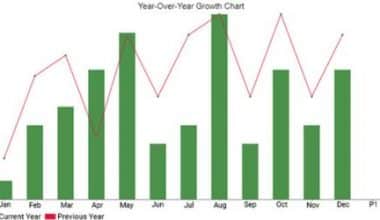Metrics are critical to your performance as a sales leader, manager, or rep. They assist you in evaluating the performance of the company, team, and individual contributors.
Assume you’re getting ready to meet with your VP of Sales. You must offer an update on your sales team’s accomplishments during this meeting. When you look at your CRM database’s abundance of dashboards and reports, all of the charts, figures, and percentages can be daunting.
Which sales KPIs have the greatest impact on the business? So, are there any that you should prioritize? Monthly recurring revenue is one metric to consider (MRR). The monthly recurring revenue helps you and your VP to calculate the amount of income made each month. You can compare MRR to the monthly sign-up rate for your product or service, monthly account growth rate, and customer retention, in addition to revenue patterns over time.
The study will tell you whether your revenue is decreasing or increasing over time, and it will also enlighten sales executives so they can make informed business decisions.
What Is MRR (Monthly Recurring Revenue)?
MRR is an abbreviation for monthly recurring revenue. It is a standardized measure of a company’s predictable revenue that it anticipates generating each month. For instance, if you have ten customers who each pay you $50 per month, your MRR is $500.
Before we begin, let’s define a few terminologies.
- Revenue: The income earned by your company as a result of the selling of goods and services.
- Recurring Revenue: This is the money you may expect on a consistent basis. Recurring revenue can be calculated on a monthly or annual basis (e.g., MRR: monthly recurring revenue, ARR: annual recurring revenue).
How does MRR work in Practice?
Consider the following: You work for a cloud computing firm that sells a photo storage platform on the cloud. Customers sign a yearly membership contract and pay a monthly charge to access the photo storage service.
Assume the client has agreed to pay $1,200 per year, and you may anticipate earning $100 ($1,200/12 months) in income each month based on their purchase. This customer’s monthly recurring revenue is $100.
Hence, after calculating the MRR for each customer, you may compute the total MRR for your company.
Read Also: Gross Profit Margin: Formula & How to Calculate the Gross Profit margin
Monthly Recurring Revenue Formula
Average Revenue Per Account X Total Accounts That Month =MRR
When calculating MRR, the most important metric is the Average Revenue Per Account (ARPA). That amount is calculated by taking the average of how much all of your clients are paying and dividing it by the total number of consumers that month.
To calculate your MRR, multiply the value by the total number of consumers. So, if you have 100 clients paying $50 per month on average, your MRR is $5,000.
How to Calculate Monthly Recurring Revenue MRR
- Determine the total revenue earned by all customers for the month.
- Calculate the average monthly payment made by all clients.
- Multiply the average number of consumers by the total number of customers.
One can calculate the monthly recurring revenue in various ways. The formula will differ depending on the one your company chooses.
For example, your company might employ the customer-by-customer strategy. So with this formula, you sum all of your clients’ monthly payments. The MRR would be $900 if you had 90 customers who paid you $10 per month.
Although the customer-by-customer method is less efficient than the ARPA method, both equations should get the same result.
But what exactly does that figure imply? And how can it be put to use? There is no single answer to either question. This is due to the fact that it can be partitioned, examined, and evaluated in a variety of contexts for a variety of objectives.
Read Also: Key Performance Indicators KPIs: 145+Examples of KPIs
Types of MRR
Breaking down MRR even further will allow you to examine revenue growth and patterns to see if there are any areas where you might improve.
#1. New MRR
The monthly recurring revenue generated by new clients is referred to as New MRR. Assume you get 10 new clients in a month, half of them pay $50 per month and the other half pay $100 per month; your new MRR would be $750.
#2. Expansion MRR
This figure indicates increased recurring monthly revenue from your existing clients. Expansion MRR is also referred to as an upgrade, and it might be the consequence of an upsell or cross-sell. Using the previous example, if four customers change their contracts from $50 to $100 per month, the expansion MRR would be $200.
#3. Churn MRR
Churn MRR is the revenue lost as a result of customers canceling or downgrading their subscriptions. So, if one client quits their $50 subscription and three other customers lower their monthly subscription from $100 to $50/month, the churn MRR is $200. As a result, you’ll have less MRR to work with in the future months.
#4. Net New MRR
This amount is computed using the three MRR types mentioned above. The net new MRR formula is as follows:
Net New MRR = New MRR + Expansion MRR – Churned MRR
The calculation’s outcome will inform you how much MRR you’re gaining or losing. If the total of new MRR plus expansion MRR is less than the total of churned MRR, you have lost money. However, if they are larger than the churn MRR, you have profited.
What is the Significance of MRR?
While monthly recurring revenue may appear to be a large picture statistic that has a high-level impact on the organization, it is just as significant to individual sales reps as it is to manage.
“MRR is the most essential financial growth statistic. Other essential measures include growth rate, retention, average sales price, and rep productivity, but the most crucial metric is the amount of monthly recurring revenue consumers are prepared to charge to their credit card or pay via invoice” HubSpot’s sales director, Dan Tyre, agrees. “Based on MRR achievement, we evaluate the performance of our companies, divisions, teams, and individuals. It’s a fundamental indicator for assessing the effectiveness of teams and sales representatives.”
#1. Performance Monitoring
How big are the deals you’re closing? It provides salespeople with information about the size of the accounts they manage. So, if you are paid a commission based on the amount of monthly recurring revenue you close, your take-home pay may be affected by the proportion of high and low MRR customers you have sold to.
Are you having trouble meeting your monthly MRR quota? Examine the high-margin deals you’ve closed.
- Is there any resemblance amongst your clientele who have purchased from you?
- Was there anything you did during the sales cycle that helped you get the sale?
Reflecting on these specifics will assist you in modifying your sales technique for the opportunities in your pipeline. Also, presumably, your research will lead to you closing high-MRR agreements.
#2. Sales projections
Sales managers and leaders may look at the large picture and evaluate how the team is doing as a whole, just as reps can look at their individual performance. They can develop more accurate sales forecasts and projections by looking at the entire MRR. And this assists the sales staff in planning for both short-term and long-term growth.
#3. Planning a budget
It is difficult to maintain a successful firm without a consistent income stream. MRR informs business leaders of the amount of money that can be reinvested each month.
Will you be able to hire any additional business development people this month? Are you able to carry out that lead generation campaign? One of the deciding elements in these scenarios is the amount of revenue you bring in.
If you’re having difficulties making ends meet, you can also look for any trends in MRR over time that may signal financial trouble.
However, if your monthly recurring revenue is increasing, it can be a source of inspiration for your sales team. Your sales reps will be more interested in their roles and eager to complete additional deals as they gain momentum and close high MRR deals.
It is an important business indicator for planning and decision-making.
Common Errors in MMR Calculation
This is a significant measure for subscription businesses, thus you must avoid certain typical pitfalls while calculating it.
Mistake 1: Including full-value quarterly, semi-annual, or annual contracts in a single month.
Even if someone pays you in full upfront, their subscription value should be split by the expected subscription period in MRR calculations. The rationale for this stems from one of MRR’s primary applications: momentum measuring. You’re not attempting to calculate cash flow. You’re attempting to gauge how rapidly and efficiently you’re expanding. Including everything at once skews many of your other KPIs, such as customer turnover rate, customer count, and so on.
All of the money would be counted in your bookings calculations.
Mistake 2: Deducting transaction fees and overdue charges.
Founders may be tempted to deduct transaction fees and late charges from their MRR totals to be more conservative and precise when computing their metrics. While the intentions are noble, the outcomes are unfortunately wrong and deceptive.
Delinquent charges fall between churn and active, especially if you normally recover any failed credit card purchases fast. The issue here is that a delinquent charge is theoretically gone in an end-of-month (EOM) calculation schema because you did not collect the subscription from the consumer. Instead, you should divide your delinquent charges into their own category. This form of grouping enables you to precisely measure and reduce the amount of money lost each month as a result of failed or expired credit cards.
Mistake 3: Including one-time payments
These aren’t “recurring,” hence they don’t belong under Monthly “Recurring” Revenue. Because you do not anticipate receiving them on a regular basis, putting them in your MRR calculations may inflate your revenue projections and skew your financial model.
Mistake 4: Including Trialers in Their Calculations
Perhaps the most egregious SaaS fault is not counting trailers and their estimated subscription value before they convert to customers. This effectively provides you with a continual high list of “net new” clients and “churned” customers, as we all know that 100% of trailers do not convert.
Mistake 5: Failure to Include Discounts
Another flagrant and deceptive blunder is failing to include discounts in computations. If you give someone a discount on a $100/month plan and they pay $50/month, your MRR is $50/month rather than $100/month. If you removed the discount, your top-level MRR would increase by $50 per month.
Improving Brand Monthly Recurring Revenue
Brands are advised to improve their MRR as this adds to the image of their company. To improve your MRR, do the following;
#1. Set Goals
Brands are encouraged to set goals and then use charts to keep track and improve their Monthly Recurring revenue.
#2. Always Calculate Your Monthly Recurring Revenue
We encourage you not just to calculate but to do so correctly. You can also use a software program to do this.
How do I determine MRR for a company with a variety of pricing plans?
When a company offers different pricing plans, MRR is calculated by summing up the recurring monthly revenue from each plan. It’s like adding up all the slices of a pie to find the whole pie’s size!
Can MRR be used to estimate future income?
Definitely! MRR gives you a good idea of the recurring monthly income a business will likely receive. So, it’s a helpful tool for estimating future income, but keep in mind that nothing is set in stone!
How is MRR different from ARR (Annual Recurring Revenue)?
MRR and ARR are similar metrics with a key difference – MRR focuses on a monthly recurring income while ARR looks at it annually. It’s like taking a snapshot of your monthly income versus a yearly one!
How does MRR aid in monitoring a company’s progress?
MRR is a great way to track a company’s progress, as it reflects the recurring revenue a business is generating each month. Think of it as a barometer for your business’s health – a rising MRR is a sign of growth, and a decreasing MRR may indicate a need for adjustment.
Conclusion
You should now be able to calculate your monthly recurring revenue using the simple formula given above. It is important to calculate your monthly recurring revenue so that you can determine the effectiveness of your marketing activities.
You also understand how properly charging your clients will assist you in increasing your monthly recurring revenue for the success of your organization.
MRR FAQs
For most companies, MRR is the sum of all new business subscriptions and upgrades (sometimes called expansion), minus downgrades (or contractions) and canceled subscriptions. … Revenue is defined as the income generated through a business’ primary operations
Does MRR include tax?
It includes the recurring items in your subscriptions such as coupons, discounts, recurring add-ons, etc. One-time charges like setup fees, non-recurring add-ons, any non-recurring ad hoc charges, and the amount charged towards taxes are not included.
What is MRR in startup?
MRR, an acronym for Monthly Recurring Revenue, is income a startup can reliably anticipate every 30 days (monthly period). MRR lets companies operate under a subscription model, as opposed to one based on a one-off transaction







